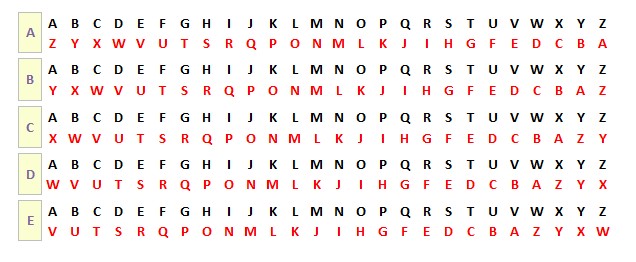Communications security -- "Diana one-time-pads"
Diana Encryption Pads
The pictures used in illustrating the diana system will resize to fit mobile devices. However, the printing will be so small that I doubt you will be able to read the letters.
With today's technology our security methods of the 60's seem simple... almost childish in their lack of complexity. Most secure web sites
use what we call 128-bit security... an incredibly strong encryption system. Our CW radio net relied on what amounts to a '1-bit'
encryption system. We accomplished this with what we called "Diana one-time-pads".
The Diana one-time-pads were essentially tablets. Each set of pads contained a pair of the tablets, except for special sets which had
multiple copies in the set. One tablet from each set was distributed to an A-Team, with Company C communications section keeping the other
copy.
Each sheet of the tablet was pre-printed with five five-letter groups on each line. These were not really words, since random letters were
used to create each group. The illustration below depicts the first two lines of a Diana one-time-pad.

When either party had traffic (messages) to send, it would call the other to establish the communications link. The originating station would
then send the first two groups of the first line they used to encrypt the message. These first two groups (highlighted in aqua, below) were
not encrypted. Since the C-Team (Headquarters) had tablets assigned to each A-Team, the C-Team radio operator would grab the tablet(s) assigned
to that A-Team and look for a line that started with the two groups received. Once he found the tablet and position used to encrypt the message,
he would send QRV to the A-Team radio operator -- meaning "I am ready to copy".

In order to prepare the message for transmission the originating radio operator would write the text of the message below the one-time-pad
groups. For example, suppose our message was: "Arc light your area next thirty six hours..." The operator would write this as
shown below. (Note: RED text used only for illustration purposes.)

Then, using a 'Tri-Graph' to derive equivalents based on letter combinations, the operator would encrypt the message. The yellow
column could be a letter in the message to be encrypted and the black letters would be a letter on the diana tablet. As you can see,
the letter combination A and G yields the letter T. (The reverse would also work. A and G or G and A always results in T.)
T would be the 'encrypted letter'.

Partial trigraph shown for illustration.
The receiving operator would write the Morse code letters he had received above the groups on the matching pad, similar to shown below
in BLUE text. Once the entire message had been received, the message would be decrypted using
the Tri-Graph... in a sense 'reversing' the encryption process. The decrypted letters would be written below the pad groups,
illustrated in RED below. (Please note that the letter patterns in the illustration below do not follow the trigraph.)

After sending and receiving hundreds of messages the radio operators had the Tri-Graph memorized. When working at slower speeds, the 'hot
shot operators' would not write the encoded letters down. They would look at the letter on the one-time-pad, hear the Morse code letter
that corresponded to the pad letter, and write only the decoded message. This was the equivalent to 'twiddling your thumbs' as a CW
radio operator.
This was how we did things on the Special Forces radio nets. After thirty-five years I can still hear the radios as they sprang to
life: "Single Squab Single Squab this is Stanley Looker Stanley Looker" We were damn good!
Tricks of the Morse code trade:
When the experienced operators were at the telegraph keys, the code came so fast that you looked for shortcuts to improve your copying speed. One of those 'secrets' involved the letter 'E'. In Morse code the letter 'E' is one "dit". At speeds around thirty words per minute you don't have time to write the letter 'E' before the next morse code letter is received! So the 'old timers' would purposely skip the letter 'E' when received. Then, after the entire message had been received, they would go back and fill in every blank with the letter 'E'. Even though some of the blanks had no doubt been caused by static crashes (bursts of noise that block reception), we had no trouble decrypting the messages.The safety of the men at our camps depended on having a communications link between Headquarters and the A-Teams. Since our radio net was restricted to one radio frequency (i.e. one message/camp at a time), we had to find alternate means of communicating. Da Nang did have an FM voice radio system, but the only A-Team within range was A-109. And since this was a voice system, we couldn't use it to send Morse traffic... until we figured out that we could use the sidetone from the Morse radio in lieu of voice.
When you send code, the radio creates sounds identical to the Morse you are transmitting. This is called the 'sidetone'. The transmitting operator uses this sidetone to monitor/listen to what he is sending. One day when the main HF frequency was busy, someone suggested that we hold the voice microphone next to the sidetone speaker. By holding down the button on the voice microphone with one hand and sending CW on the other radio with the other hand, we could send CW over the voice radio. This method was used frequently between A-109 and Det C-1.
